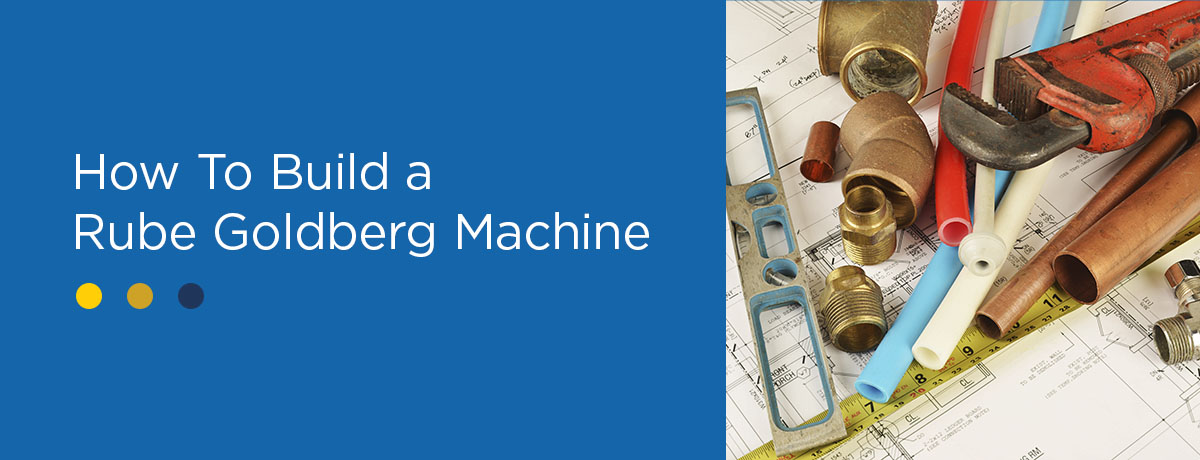Enrollment Now Open for Second Semester. Click Here
Enrollment Now Open for Second Semester. Click Here

REQUEST INFORMATION
Table of contents:
If you want to help your child have fun, exercise their creativity, and learn about simple machines, why not help them create a Rube Goldberg machine? This post will explain what these machines are and share some easy Rube Goldberg machine ideas to help you get started.
To understand what a Rube Goldberg machine is, it may help to know about Rube Goldberg himself. Rube Goldberg has become synonymous with elaborate machines featuring chain reactions that overcomplicate a basic task, but Rube Goldberg wasn’t an inventor — he was an American Pulitzer Prize-winning cartoonist.
Goldberg had an engineering degree, which, combined with his art skills, helped him delight people with his crazy mechanical creations. In the comics, these machines were invented by a character called Professor Lucifer Gorgonzola Butts. The devices may have been fictional, but they were designed to work and were labeled in the style of United States patent applications. In the early 20th century, as the machine age was taking off, Goldberg’s cartoons satirized society’s obsession with all things mechanical.
Today, children and adults alike enjoy making their own Rube Goldberg machines — that is, simple machines with a series of chain reactions that ultimately accomplish a simple task in a delightfully convoluted way. Creating these machines can help develop learners’ science, technology, engineering, and mathematics (STEM) skills. It can also encourage their creativity and collaboration skills.
To create a Rube Goldberg machine, you should start with the end of the chain reaction and work your way backward to figure out how you want to get from Point A to Point B. For example, if you want the final action to be flipping on a light switch, you first need to decide how you’ll push up on the light switch, then continue working backward so that each movement is caused by the movement before it.
Flipping on a light switch is just one idea. Here are a few other Rube Goldberg machine ideas to help you choose the task your machine will accomplish. You could:
Rube Goldberg machines are, by definition, simple machines. That may seem contradictory to the elaborate, convoluted nature of these machines as we described them. However, what makes these machines appear complex is the series of chain reactions. Each individual part of the machine is a simple mechanical device that applies its own force. You can create these machines using humble household materials and basic physics principles.
Let’s look at a few examples of mechanical devices kids can put together to create their own Rube Goldberg machine.
Marble runs, or marble chutes, are a fun and effective choice for Rube Goldberg machines. If this is the first step of your machine, you can drop a marble into the start of a chute or track. If this step comes somewhere in the middle of the device, a previous action can push the marble into the chute. When the marble emerges out of the end of the chute, it should cause the next chain reaction.
You may be able to use a plastic racecar track for your marble run, or you can cut something like a wrapping paper tube or a PVC pipe to create one. Keep in mind that if you can see the marble as it runs along its track, it adds to the fun of watching your machine work.
Levers are a common feature in Rube Goldberg machines. One of the easiest ways to teach a child about this simple machine is to point to the seesaw at the playground. When you apply pressure to one end of a rigid bar resting on a fulcrum, the other end should rise up.
For example, at the end of your marble run, the marble could roll off a ledge into a cup on one end of a lever. If the marble is heavy enough, it’ll push that end of the lever down, elevating the item on the other end of the lever. That other item could bump into something, causing the following chain reaction to occur. You can create your own lever using basic materials like a binder clip and a ruler.
When most people think of a Rube Goldberg machine, there’s a good chance they picture a series of dominoes falling. In fact, dominoes are so strongly associated with chain reactions that we often use the term “domino effect” to mean a chain reaction of events.
When you want to apply force to an object in your machine, you can set up a line of dominos. Correctly spacing the dominos will ensure that just pushing the first domino over causes the whole line of dominos to fall, with the last domino applying the force you need to lead to the next step in your machine.
To help your child have a positive experience creating their own Rube Goldberg machine, follow these five tips:
At Commonwealth Charter Academy, we believe parents should be a key part of the equation when it comes to their child’s learning — and that’s possible with our engaging cyber school curriculum. If you’re interested in joining the CCA community, take a moment to learn more about how we involve families in the learning process and enroll today.
Enrollment Now Open for Second Semester. Click Here